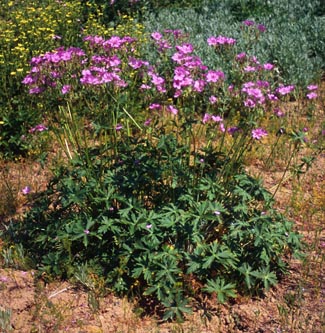Sticky Geranium

Common Name(s):
Sticky Geranium
Sticky Purple Geranium
Scientific Name:
Geranium viscosissimum Fisch. & C.A. Mey. ex C.A. Mey.
Scientific Name Synonyms:
None Known
Symbol:
GEVI2
Description:
Life Span: Perennial
Origin: Native
Season: Cool
Growth Characteristics: A flowering forb, growing 20-50 inches tall, with 1 to a few stems. Stems are stout, forked, and hairy. Flowers May to August, fruits mature August to September, it reproduces by seed.
Flowers/Inflorescence: Sticky Geranium has two to several flowers in open clusters, often 2-forked well above the leaves. The flowers have five sepals and five petals. Petals are long, rounded to slightly notched, pinkish-lavender to purplish, seldom white, and soft long-hairy at the base for about ¼ of the length. The 10 filaments are joined at the base.
Fruits/Seeds: Each seed is tipped with an elongated tail, which coils spirally at maturity, assisting the pointed seed in penetrating the soil. The fruits are capsules which are stiff-haired.
Leaves: The leaves are mainly basal and long stalked, with flat stiff hairs and glands which exude a sticky substance. The blades are 2-6 inches wide, palm-shaped, with the 5-7 sharply toothed divisions cut more the ¾ their length. If stem leaves occur, they are few and mostly opposite.
Stems: The lower part of the stem and leaf stalks are spreading to flat-stiff-hairy, often glandular-long hairy above, especially among the flowers.
Ecological Adaptions:
Found in drier grassland and forests, sometimes in moist meadows, plant-montane zone.
Soils: Grows best on moist to semiwet soils with good drainage. It prefers loam, sandy loam, and clayey loam soils derived from shale and limestone, but occurs on gravelly substrates as well.
Associated Species: Sagebrush, rabbitbrush, larkspur, lupine, willows, sedges, brome grasses.
Uses and Management:
The flowers of sticky purple geranium are edible, and can be added to salads or used as a garnish. The leaves are edible raw or cooked, but are not choice.

